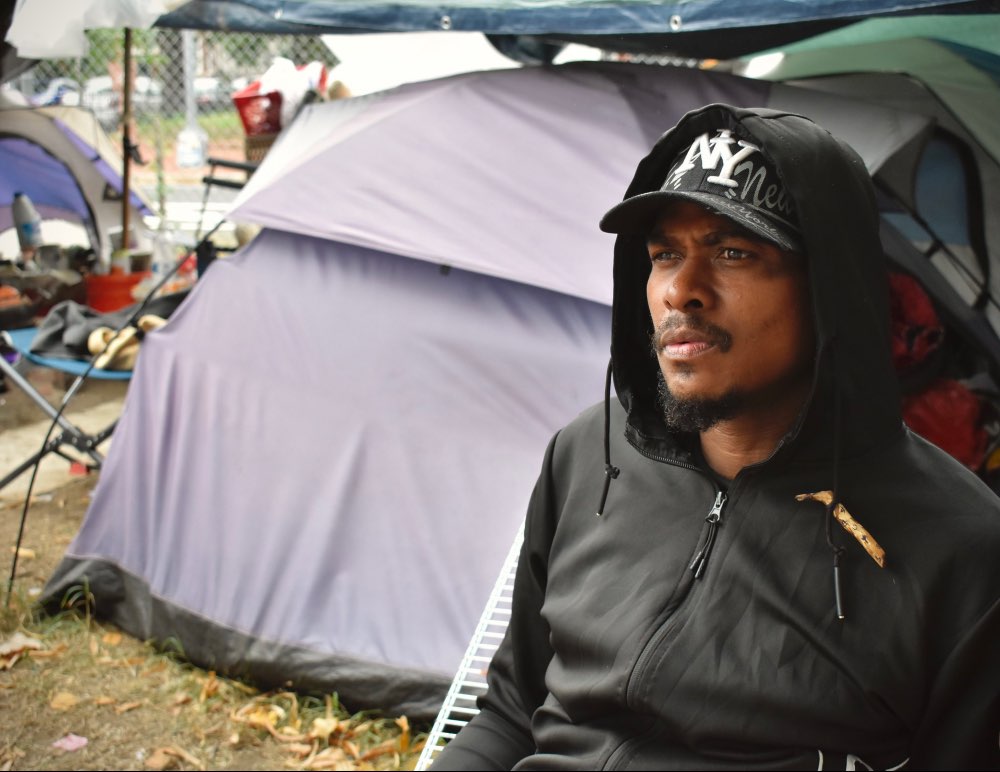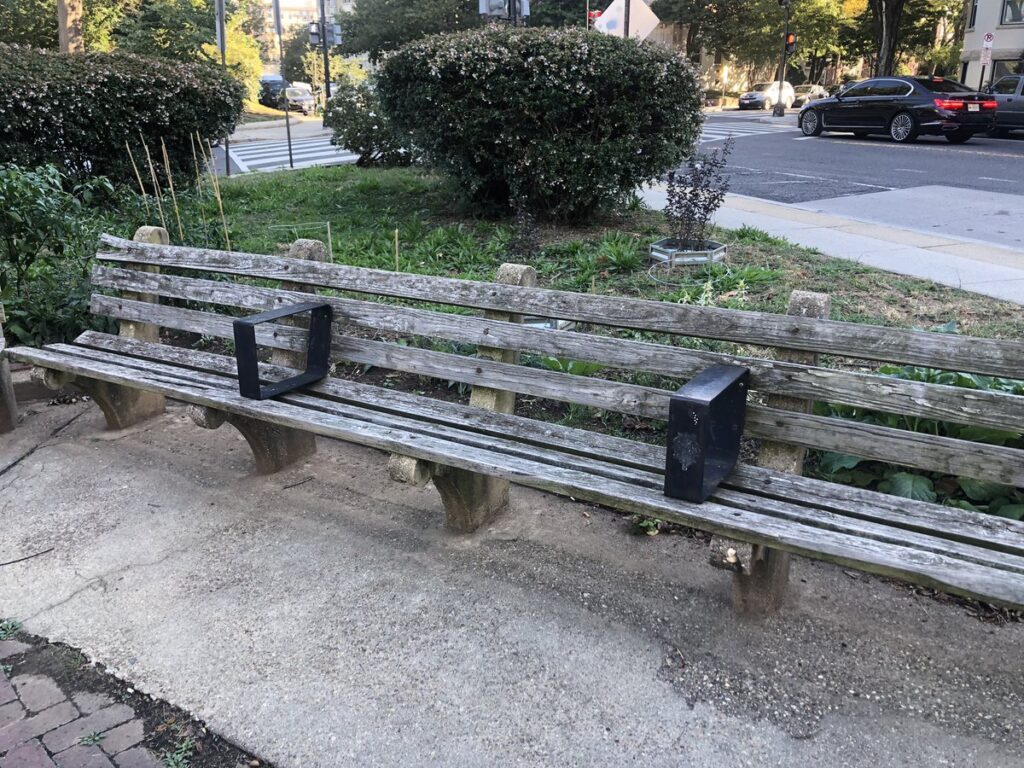David, Josh, Ray, and 10 other people lived for over two months in a small triangle park at 3rd Street and Massachusetts Ave. NE near Union Station. However, in the last two weeks, they found themselves scrambling to look for a new place to stay after the National Park Service (NPS) posted a notice on Sept. 30 saying they would close the park on Oct.15.
According to NPS, the agency closed down the Massachusetts Avenue encampment because it was a safety hazard. NPS received many reports “about health and safety issues and violations that have gone on here,” said Sean McGinty of the Park Service. “The fire marshal has had to visit this particular area a couple of times due to the illegal operation of a grill, and a generator within the area. The amount of trash accumulated, the close quarters of individuals living in fabric housing tents together.”
A week before the closure, NPS put tall, metal fencing up around the triangle park encampment with tents still inside. The agency used the same approach in August when closing two small triangle parks where people had been living in Northwest, also along Massachusetts Avenue.
“If there was a fire that occurred here, it could have been devastating to the individual victims,” McGinty said. “We really are as concerned about the issue of homelessness and these individuals’ safety as anybody else. That is why we are doing this.”
The fire threat from encampments is real. Fire at a park encampment in Truxton Circle killed one homeless resident earlier this month.

Simon is a good friend to most of the people on 3rd and Mass. Ave. He was there to ensure that his friends had the opportunity to move comfortably. Simon said that he believe 14 days in not a long time to move. “Imagine moving out of your apartment in 14 days,” he said.
By Maydeen Merino
NPS said they worked with the Deputy Mayor for Human and Health Services (DMHHS) to provide housing applications or shelter options. David and Josh said that they were added to the city’s list of people in need of housing more than a year ago.
“They still have not matched us to vouchers, and they said it could take up to five years,” Josh said.
Where else can homeless people go?
In August, the D.C. Council added dedicated funding for various housing subsidies to the city’s budget by raising taxes on residents who make more than $250,000 a year. A spokesperson for the Department of Human Services previously told Street Sense Media this led to 1,924 permanent supportive housing vouchers for the fiscal year that began this month, over 30% more than the previous fiscal year.
Josh said that when he heard about the increase, he went to Mayor Muriel Bowser’s office to ask whether there would be more available housing vouchers, but they told him “no.” He emphasized that with the cost of living increasing makes it challenging for him and others to find a place to live.
“This is their only place to live, and this is their only option. This is my only option at the moment, too. I have been looking for a year to find a place that I can afford, and it’s just that everything keeps going up,” Josh said.
While the park closure was not carried out by the city, DMHHS — which coordinates D.C.’s response to encampments — still sent outreach groups several times to provide NPS with assistance in presenting shelter options and housing applications for the residents.
[Read more: FAQ: How to apply for housing in DC and what to expect]
“We continue to work with NPS regularly to learn of any closures in advance so that we can properly engage the encamped residents beforehand,” Deputy Mayor for Health and Human Services Wayne Turnage wrote in a statement to Street Sense Media.”And encourage all encamped residents to utilize District shelter options and to regularly engage in outreach provider service connection efforts.”
Many residents explained that shelters were not an ideal option because of the conditions and rules.
“I started at 2nd and D [NW] shelter. And I stayed there for like six months, but it was too much. It was like jail,” David said.
Ray is waiting to get her birth certificate so that she can obtain other forms of ID needed to access additional assistance. After her legal guardian, which is her sister, did not want to continue to take care of her, Ray said she was sent to a psych ward in Nebraska and then sent here. For the last four months, Ray has been on the streets but hopes to get some help getting a job soon.
“If they want us to be off the streets, then they need to make sure that we have applicant homes to go to and help give us jobs. Mainly, it’s the jobs that have made most of these people homeless,” Ray said.

Being forced out of an encampment is nothing new for most of the residents. Many used to live at a triangle park down the street at 2nd and Mass. Ave. NE, where they were also forced to leave. NPS closed that park at the end of July because of a tree rotting from the inside. McGinty said there were concerns about the possibility of a tree falling on someone.
“The situation that we had over there is we could not move our stuff, so we just got a few little carts and brought the stuff over here. We didn’t have any other options, and now we are in the same boat again,” Josh said.
At-Large Councilmember Elissa Silverman was at the park to witness the encampment closure process. She is concerned that the city does not have a coordinated strategy around encampments.
“People are moving to different places to have the same issue arise with different neighbors. I do not think that is a strategy,” Silverman said.
DC’s pilot program for city encampments
The previous week, Silverman sent a letter to DMHHS recommending the agency develop an agreement with NPS outlining how encampments on NPS property will be “monitored for health and safety” and how each will operate ”in the event of the closure of an NPS site.”
“Nobody thinks a successful encampment mitigation strategy is to close and fence off one area only to see all the same people and tents move to another area down the street,” she wrote, noting there are 119 encampments in D.C.
The District launched a pilot program this autumn that aims to get homeless residents new living arrangements quickly after closing the public spaces in which they were living. The Coordinated Assistance and Resources for Encampments program initially targets three of the city’s largest encampments.
The pilot started with an early October eviction from two underpasses in NoMa, but that removal was halted after city staff picked up a tent with a resident still inside. In her letter, Silverman recommended that DMHHS “pause all encampment clearings while continuing the intensive services and housing outreach of the pilot.” But the next week, eight council members — a majority of the legislature —.signed a letter asking that all aspects of the pilot program move forward but that DMHHS provide detailed information on its increased safety protocols. Although the council members support the initiative they asked that once the pilot is complete to continue discussion on what worked and what did not.
“We ask that you provide the Council with data on the progress and outcome of the pilot program including specific metrics on applicability of subsidies and number and length of leases and wrap around services provided,” the letter states.
The program is not able to accommodate everyone. Many NoMa encampment residents interviewed by Street Sense Media did not make the list to receive immediate housing placement. The program included 90 days of canvassing and outreach at the encampment sites. Aug. 29 was the cut off date to sign up for temporary housing. Residents not on the “by-name list,” had no choice but to relocate.
DMHHS has conducted at least 32 “full cleanups” — where people are forced to temporarily leave an area and any unclaimed belongings are trashed — in 2021, according to Street Sense Media’s monitoring of the agency’s website. NPS could not give a tally for how many times people have been removed from federal parks in the District this year or if any parks have been fenced off completely other than the four mentioned in this article.
The fate of the park
Triangle park residents at 3rd and Massachusetts were not given the immediate housing opportunity associated with the city’s pilot program. Both the park and the removal of people from it are under federal jurisdiction. Twenty percent of land in the District’s — and 90% of its park land — is under NPS jurisdiction, according to the agency’s website.

A week before the closure, the residents began to look for somewhere new to live. They settled at a park not too far from where they were with the plan to stick together. A mutual aid group helped them get a U-Haul to move all of their stuff.
Half the residents had already moved before the closure date. The rest took over an hour to finish packing their items and leave Friday morning. Several mutual aid groups, including the People’s for Fairness Coalition, showed up the morning of the closure to help the residents move and monitor how they were treated by authorities.
“This is an important day to make sure the park police do their job,” said Anderson, a member of the People’s for Fairness Coalition and Street Sense Media vendor. There were at least five law enforcement officers from U.S Park Police overlooking residents and volunteers carrying belongings to the U-Haul.
The tall metal fences remain. NPS told Street Sense Media they have not committed to re-opening the park at any specific date. The posted sign says “The park will be closed with fencing and will remain closed until the safety hazard and other resource damage is addressed. Violation is prohibited.”
###








